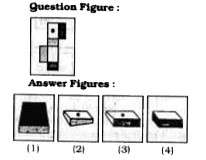Sixteen cylindrical cans each with a radius of 1 unit are placed inside a cardboard box four in a row. If the cans touch the adjacent cans and or the walls of the box, then which of the following could be the interior area of the bottom of the box in square units ?
16
32
64
128
The correct Answer is:C
To solve the problem, we need to find the interior area of the bottom of a cardboard box that holds 16 cylindrical cans, each with a radius of 1 unit. The cans are arranged in a grid of 4 rows and 4 columns.
1. Determine the Diameter of Each Can:
- The radius of each can is given as 1 unit.
- The diameter (D) of each can can be calculated using the formula:
D=2×radius
- Therefore, the diameter of each can is:
D=2×1=2 units
Hint: Remember that the diameter is twice the radius.
2. Calculate the Total Length for the Cans in a Row:
- Since there are 4 cans placed in a row, the total length (L) occupied by the cans can be calculated as:
L=number of cans×diameter of each can
- Thus, the total length is:
L=4×2=8 units
Hint: Multiply the number of cans by the diameter to find the total length.
3. Determine the Dimensions of the Box:
- Since the cans are placed in a square arrangement (4 in a row and 4 in a column), the width (W) of the box will be the same as the length:
W=L=8 units
Hint: In a square, all sides are equal.
4. Calculate the Area of the Bottom of the Box:
- The area (A) of the bottom of the box can be calculated using the formula for the area of a square:
A=length×width
- Therefore, the area is:
A=8×8=64 square units
Hint: For a square, the area is found by squaring the length of one side.
5. Conclusion:
- The interior area of the bottom of the box is 64 square units.
Final Answer:
The interior area of the bottom of the box is 64 square units.
- The radius of each can is given as 1 unit.
- The diameter (D) of each can can be calculated using the formula:
D=2×radius
- Therefore, the diameter of each can is:
D=2×1=2 units
- Since there are 4 cans placed in a row, the total length (L) occupied by the cans can be calculated as:
L=number of cans×diameter of each can
- Thus, the total length is:
L=4×2=8 units
- Since the cans are placed in a square arrangement (4 in a row and 4 in a column), the width (W) of the box will be the same as the length:
W=L=8 units
- The area (A) of the bottom of the box can be calculated using the formula for the area of a square:
A=length×width
- Therefore, the area is:
A=8×8=64 square units
- The interior area of the bottom of the box is 64 square units.
The interior area of the bottom of the box is 64 square units.
Topper's Solved these Questions
- VOLUME AND SURFACE AREA BOOK - S CHAND IIT JEE FOUNDATIONCHAPTER - VOLUME AND SURFACE AREA EXERCISE - Self Assessment Sheet - 26
10 Videos
- TRIGONOMETRICAL RATIOS OF STANDARD ANGLES BOOK - S CHAND IIT JEE FOUNDATIONCHAPTER - TRIGONOMETRICAL RATIOS OF STANDARD ANGLES EXERCISE - Self Assessment Sheet - 32
10 Videos
Similar Questions
Knowledge Check
Which of the following can be filled in a decision box?
AA,B,CBB,C,DCA,B,DDA,C,DThere are four balls of different colours and four boxes of colours same as those of the balls. The number of ways in which the balls, one each in a box, could be placed such that a ball does not go to a box of its own colour is _
Aa. 16Bb. 9Cc. 4C2Dd. none of these
How many spherical balls of radii 2 cm can be placed completely inside a cubical box of edge = 8 cm?

View SolutionThe areas of the three adjacent faces of a cuboidal box are x, 4x and 9x square unit. What is the volume of the box?
View SolutionFind the number of ways in which four distinct balls can be kept into two identical boxes so that no box remains empty.
View SolutionThere are four balls of different colors and four boxes of colors same as those of the balls. Find the number of ways in which the balls, one in each box, could be placed in such a way that a ball does not go to box of its own color.
View SolutionThere are four balls of different colours and four boxes of colours same as those of the balls. The number of ways in which the balls, one in each box, could be placed such that a ball does not go to box of its own colour, is
View SolutionThere are four balls of different colours and four boxes of colours same as of the balls the number of ways in which the balls, one in each box, could be placed such that a ball does not go to a box of its own colour is
View Solution

